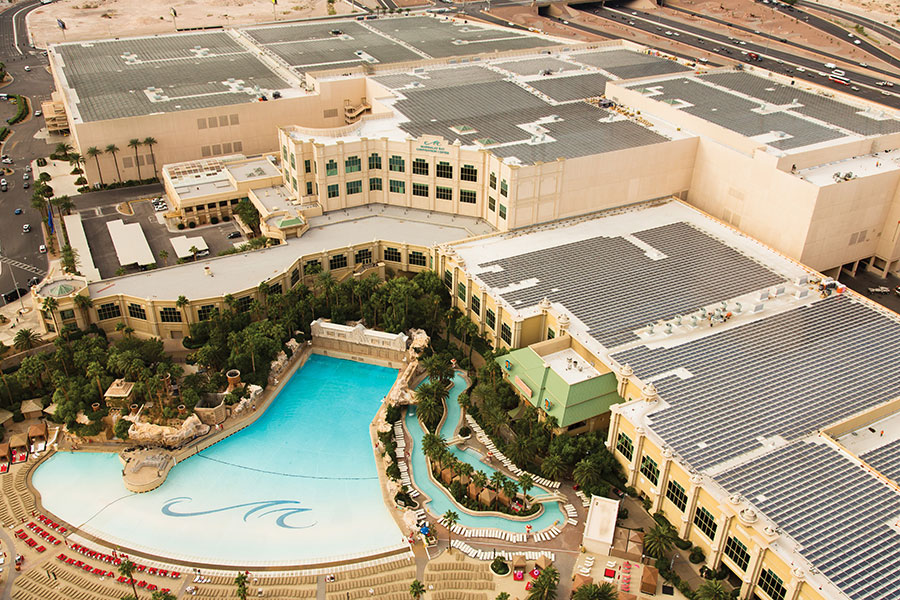In the middle of a construction site, amongst the dust and noise that is more suited to a burly construction worker, stands a woman in a neatly pressed business suit wearing a hard hat. It’s Cindy Ortega (pictured above), senior vice president for corporate sustainability at MGM Resorts International. She’s surveying what is now the largest privately funded construction project in the history of the United States, a 16,800-square-foot area of Las Vegas known as CityCenter. The $9.2 billion project has seen a new city of seven buildings rise from the desert floor to become the most LEED (Leadership in Energy and Environmental Design) Gold certified construction projects in the world.
While newly constructed cities around the world face a challenge of how to integrate sustainability into long-term planning, along with the constraint of government red tape, it has taken a private company to demonstrate how its done.
“We feel that part of our responsibility is to spread the word about environmental responsibility,” says Ortega. “CityCenter proved that you can build luxury responsibly on a large scale.”
The large scale Ortega mentions is staggering. More than 41,000 hotel rooms and suites are associated with MGM Resorts’ ten major resorts on the Las Vegas Strip. A dedicated 8.5-megawatt natural-gas power plant was built to power CityCenter, reducing emissions and deploying waste heat to swimming pools throughout the development. 52,000 MGM Resorts employees live in Las Vegas, spreading the MGM Resorts’ influence way beyond its borders and you could build four Eiffel Towers with the amount of steel used in one section of CityCenter alone. Of course, being Vegas, they already have a replica Eiffel Tower.
Built primarily to take advantage of the 40 million visitors to Las Vegas every year, Ortega had no idea of the global attention CityCenter would attract. “Five years on, I would never have guessed I’d be invited by countries around the world to share ideas around CityCenter and advise major metropolitans on environmental sustainability,” she says.
It’s made Ortega realize that if you include stakeholders, vendors and suppliers in the greening of your environmental footprint, you will create the added value of seeing your values spread beyond the construction site – into supply chains and communities.
“Business is one of the key factors in changing the future,” says Ortega. “In 2007 we were all a little sceptical about the implications for a business ‘going green.’ Most businesses were pretty conservative in this area, so I began to research how we could achieve something remarkable.”
What Ortega came up with was a formula that looked crazy at the time. She approached CityCenter president, Bobby Baldwin, with her report and asked if this was something he really wanted to do. His reply was, “Cindy, if we don’t do something now our environmental footprint is going to step on our children.”

It’s a company-wide attitude that keeps surprising Ortega in pleasant ways. Recently, she approached company chairman James Murren with some cutting-edge technology she wanted to introduce as part of the sustainability program at CityCenter. “I thought he was going to postpone it for sure,” she says. “But he gave me more budget. He’s genuinely committed to us being a better steward of the environment.”
Before heading up MGMs sustainability drive, Ortega’s previous job was in finance. While monetary management might seem unrelated to the environment, Ortega is convinced that it’s actually the best way to approach sustainability.
“What I’ve learned from the MGM project is that the business of sustainability is successful only when it’s an effective business practice,” she says.
This effective business practice was put to the test in 2008 when the economic downturn hit Vegas hard. MGMs stock went from around $100 to just under $2 over a three-month period. The company went into survival mode and reviewed costs across the board. Ortega’s environmental plans turned out to be a benefit rather than a liability. “If MGM had viewed my ideas as ‘nice to have,’ I would have been first on the chopping block,” she says. Her ideas and policies turned out to be a good investment. Many other companies fail to see that ‘going green’ can also read ‘money saved.
When Ortega first introduced her green ideas into Las Vegas, it was done quietly, behind the scenes. A city known for its escapist hedonism didn’t want to be prescribed rules or to have patrons ‘guilted’ into behaviour change. Today, she’s beginning to see a very different mindset. “Increasingly, guests are finding it unacceptable when a business doesn’t show a commitment to the environment,” she explains. Large, sophisticated corporations, that make up 25 percent of MGM’s room revenue, now demand a more environmentally aware service and are less compromising with whom they do business.
“It comes down to getting buy-in from your suppliers and from effective team work within your company,” says Ortega. “Sustainability does not happen in isolation. When a company positions itself as a leader in a particular field, it has to behave in a way that is harder than usual. Ultimately, people will become better at what they do if they work for a company that demonstrates good leadership.”
How CityCenter Puts Sustainability To Work
- To build an energy and water-efficient resort in the middle of the desert, MGM looked carefully at the location of buildings, what direction the windows were facing and the type and size of trees to be planted.
- Choosing water-wise fixtures helped conserve 33% of water and $40 million worth of sustainable, ethically-sourced wood was chosen, despite the increased cost.
- Three different types of cooling systems are used, to work most effectively with the different styles of construction. Instead of traditional ceiling vents, in buildings with high ceilings, cooled air comes from under the floor or from cold water pipes underfoot. Air contaminants are pushed upwards, away from guests.
- Faced with an 8 percent recycling rate and 300,000 tons of waste, CityCenter capitalised a small, local recycling company with a $2 million loan. They built a facility, bought trucks and paid the loan back through their services. Las Vegas now has a construction-recycling infrastructure.
- MGM encourage large companies to work with small, minority and women-owned businesses. In the first phase of CityCenter, an experienced company with no minority or female shareholders was required to work with a smaller, qualifying company that built the framework for a skyscraper to the 4th floor, with the larger company completing the job to the 55th floor.




































